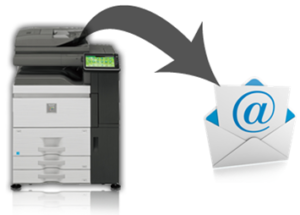Why scan to email can be bad idea
 So you’ve purchased a multi-function copier device or something else that has the ability to do “scan to email”, and you want to set it up because it sounds like a good way to go. Easy. Convenient.
So you’ve purchased a multi-function copier device or something else that has the ability to do “scan to email”, and you want to set it up because it sounds like a good way to go. Easy. Convenient.
Just because you can doesn’t mean you should. Here are some things to seriously consider before jumping on that bandwagon
- If your machine is down the hall or right next to you- scanning to email makes your scan go around the country and bounce off various mail servers and pass through all kinds of equipment before it makes it back to you. That’s a very long trip for such a short hop. There’s a lot that can go wrong and it’s going to take longer to get your scan.
- Scanning everything to email jams up your mail system and mail client with lots of additional data that doesn’t need to be there. Email doesn’t make a very good storage system- that’s what folders on your computer are for, and those folders on your computer are better suited for storing that kind of information.
- To have the machine send email, you need to configure it with an email account that it can use for sending. Some are easier to set up than others. Some email systems require very specific settings that many machines simply can’t do. Sometimes we can work around this by adding extra layers of technology to the process to make it work, sometimes we can’t and need to use a different email system and address.
- Security protocols can change or be discontinued, so scan to email may stop working at any time until you can have your support company update the firmware in your machine (if the mfg has issued updates for your model). This has happened before and will happen again.
- Your mail provider may decide to block your machine from sending emails until some kind of verification or authentication is performed. They do this to help prevent spam.
- On the other end, the recipient’s anti-spam system may block them from receiving the email. Now you’ve got to try to figure out how to not have these emails blocked.
- There is a size restriction on outbound email. You can’t send files as large as you want, which means there’s a maximum. This goes by email size, not number of pages, so you won’t know how many pages is the max, because different pages have different sizes.
- If the password changes on the account the machine is using to send, you’ll need to update the password in the machine to continue to scan.
- How will you know if the recipient got the email or not? If that message bounces, the machine won’t be able to read or respond to it.
- This is the big one. Security. Assume that everything you scan will be read by somebody that wasn’t supposed to get it. For the same reason you shouldn’t email sensitive information like credit card numbers, social security numbers, passwords, or whatever, email can be intercepted, hacked, forwarded, or otherwise read by others. If you’re a medical provider (no, this is NOT HIPAA compliant) or are handling somebody else’s personal information, you’re exposing yourself and people you deal with to liability and theft of their information when you scan to email. Imagine if it turns out you’re the reason somebody got their identify stolen?
Expect scan to email to periodically stop working and need maintenance to keep it working. There’s a lot of moving parts and a lot that can go wrong.
There are better alternatives to scanning that don’t involve email, like scanning directly to your computer, then selectively emailing what you want to others.
If after all this you still want to scan to email, OK! That’s your choice, but at least you you know the risks and can make an informed decision now
FAQ’s:
Q: This should be easy. Why is it so hard?
A: Yes, it used to be super easy. You can thank spammers and hackers for ruining it for everybody!